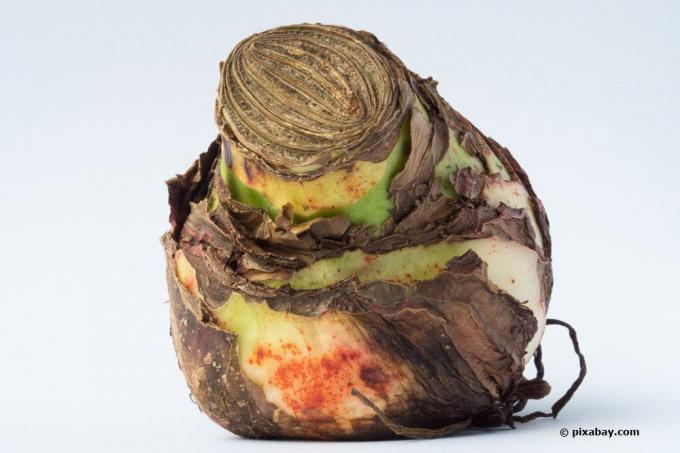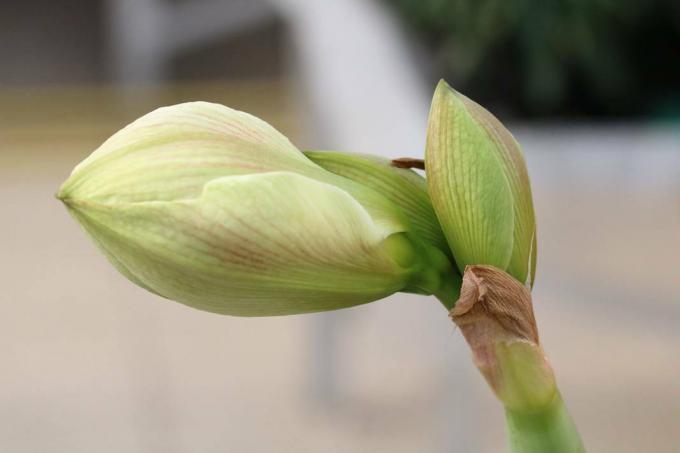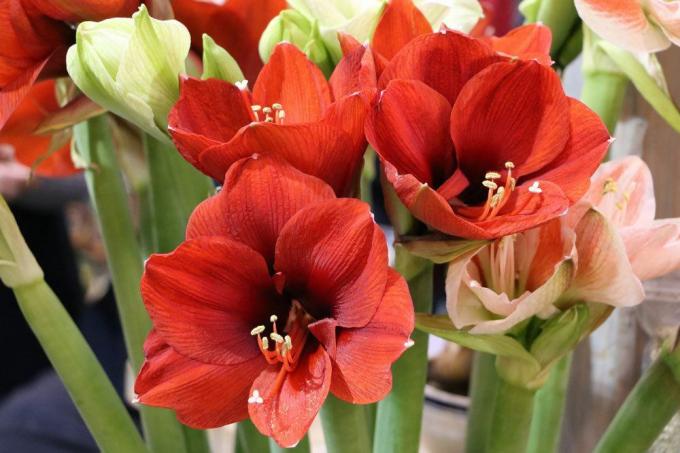
table of contents
- Risk of confusion
- botany
- instructions
- blossom
- In the glas
Amaryllis, the knight's star, is one of the most popular subtropical plants in the garden and requires special care throughout the year. Since the main flowering time of the plant is in the middle of winter, a special care program is required in summer, through which the winter flowering plant can collect sufficient nutrients for flowering. This process is called "overwintering" and theoretically represents a second "overwintering" of the plant. Oversummer is important to make knight stars bloom.
Risk of confusion
So that you don't “overwinter” the wrong crop over the summer, you need to know that there are several plants known as amaryllis. These would be the ones listed below.

Knight stars (bot. Hippeastrum)
The knight stars originally come from the summer-dry areas of South America and grow there with an onion as a persistence organ. Due to their origin in the southern hemisphere, they bloom in winter and do not lose their leaves over summer. They reach a height of up to 80 cm and are poisonous to all parts of the plant. The various phases of vegetation throughout the year, such as the rest period in summer to overwinter Hippeastrum, are particularly important when caring for the knight's stars. In total there are about 80 species in the genus, which are distributed all over South America.
amaryllis
Compared to the knight stars, the amaryllis is a small genus with only two species.
- Belladonna Lily (bot. Amaryllis belladonna)
- Amaryllis paradisicola
They are found exclusively in South Africa and resemble the knight stars only in terms of the organ of persistence, the morphology and a preferred, dry location. Compared to the knight stars, they bloom from August and do not develop any leaves. In addition, the stem is not hollow as in Hippeastrum. In Central Europe, the Belladonna lily is usually offered, which due to its botanical name is confused with the knight stars, which are also popularly known as Amaryllis.

botany
The reason for confusing the two genera lies in their botanical history. The Swedish botanist Carl von Linné wrote both genera in the mid-18th century. Century summarized in one genus under the name "Amaryllis", although the differences except for the appearance of the plants are quite large. In the course of further research, the knight stars were removed from the genus Amaryllis and recorded as a separate genus Hippeastrum. Both genera belong to the family of Amaryllis family (bot. Amaryllidaceae), which is clear from the visible, morphological features. As a precaution, double-check whether you have a Belladonna lily or a knight's star at home.
Tip: If you are interested in purchasing an amaryllis plant, you should ask the dealer directly for the botanical name. From this you can immediately see whether it is a knight's star, which is what makes summering necessary in the first place.

instructions
"Overwinter": Instructions
Oversummer is especially important for the knight, as this time is needed for new buds to form. These are formed inside the onion and are therefore not visible. This time begins right after the ice saints, at the latest at the end of May. Earlier is not recommended, especially if you want to keep the knight stars outdoors in order to make use of the numerous rays of sunshine. Before you can start over-summering, you need to prepare the plant for its summer quarters.
1. If you haven't removed the withered flowers and stems from the winter by this point, you must do so now. Remove these with a sharp knife or scissors. Both tools should be absolutely clean.
2. Then get the plant used to "overwintering" by placing it in a partially shaded location. There, the knight's star can get used to an increased amount of sunlight over eight to ten days and thus prepare for summer. The location also stimulates the formation of the buds.
These two steps are important so that Hippeastrum gets enough incentives to "overwinter". After the waiting period, you can move into the right summer quarters.
Follow these instructions on how to spend the summer:
1. Choose either a location in the garden that has plenty of sun, or a window sill, the winter garden, balcony or terrace. A southern orientation is particularly recommended.
2. If you want to summer the knight's star in the bed, you should definitely put it in the pot directly in the soil. The bulbs of the plant are extremely digestible for rodents such as voles in the open air and the pot protects the amaryllis from rodents when they "overwinter".

3. The temperature should be over 20 ° C to 28 ° C throughout the summer. Short periods of heat above 30 ° C are tolerated as long as there is sufficient watering. If it should be cooler than 20 ° C. you definitely have to bring the plant in overnight.
4. Water is particularly important when spending the summer. Water regularly, but make sure that there is no waterlogging. The saucer of the pot should only be filled with water until the earth is moist. Throw away excess water.
5. Additions of fertilizers over the summertime are essential and must be administered every 14 days. For this you can use your usual fertilizer, which you already use during the flowering period. If you are new to knight stars, you should use special amaryllis fertilizers whose formula is tailored to the needs of the plants. These are offered by companies such as COMPO or Green24. From September onwards, fertilizers will be discontinued, as it will now move into the complete resting phase before the next bloom.
blossom
What to do when the plant blooms
It can happen that the knight's star blooms over the summer, especially if a consistently favorable temperature is possible. The best thing about the flower: You don't have to remove it and you can enjoy it on warm days. However, the amaryllis then needs a little more care because it does not stop blooming and continues to develop new flowers. If your knight star blooms over the summer, proceed as follows.
- let the flowers bloom completely until they wither
- then cut the stem carrying the flowers consistently
- however, the leaves must not be injured or cut off
- only withered leaves may be removed
- most of the flowers will form on the main stem
- this can also be completely cut down to the root after it has faded
By doing these pruning measures, you will maintain health and nutrient intake over this important time. Wilted flowers only rob Hippeastrum of energy that is needed for bud formation. For this reason, these must be completely removed. Otherwise, take care of the plant as described above.
In the glas
Summer in a glass?
If you have grown your knight's star in a glass so far, you will unfortunately have to move the plant into a pot over the summer. The reason for this is the high nutrient requirement of the plant, which is more effectively covered by a substrate. This step is necessary right at the end of the flowering period, when the plant is cut and prepared for its spring and summer quarters.

Proceed as follows:
1. Prepare a pot for the knight star and fill it with substrate. This should be a mixture of high-quality potting soil and cactus substrate, which provides the plant with sufficient nutrients.
2. Carefully take the plant out of the jar, being particularly careful not to damage or even tear off the roots. Drain the root ball on a little kitchen paper.
3. Then put the knight's star directly into the pot. The onion is set halfway into the ground and all roots must be covered.
4. Then take care of the plants as described above and you can easily keep them outdoors over the summer. After the amaryllis have "hibernated", you can put them back in a jar if you like it more. However, this saves you work in the following year.



